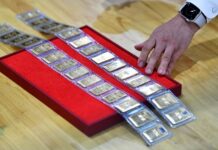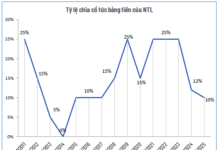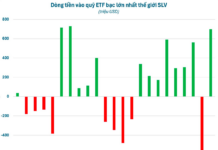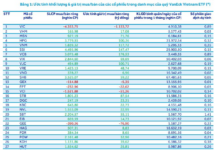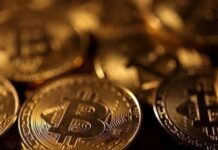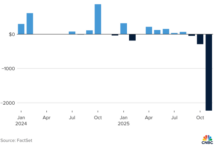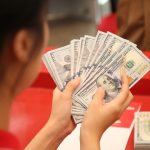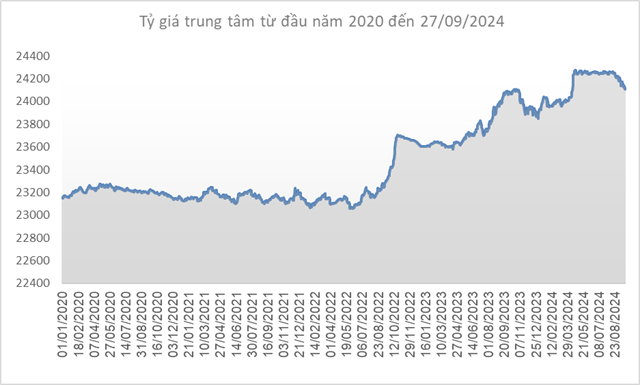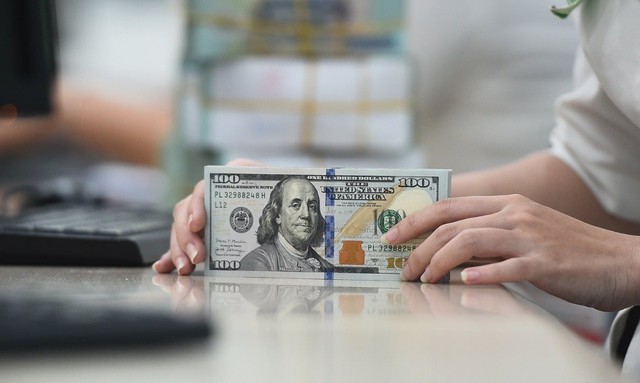
Illustration
A survey of the free market this afternoon (June 27) showed that the USD exchange rate at foreign currency exchange points in Hanoi had all surpassed the 26,000 VND/USD threshold for sales, the highest level ever recorded. The purchase price of USD in the free market has also increased to the range of 25,900 – 25,950 VND/USD.
On the official market, today’s central exchange rate announced by the State Bank is 24,264 VND/USD, up 6 VND compared to yesterday’s listing price. With a 5% margin, the current USD exchange rate for commercial banks is allowed to trade within the range of 23,051 – 25,477 VND/USD.
The intervention USD selling price continues to be listed by the State Bank’s Treasury at 25,450 VND/USD.
Following the upward trend of the central exchange rate, banks today listed the USD selling price at the ceiling of 25,477 VND/USD. Meanwhile, the USD buying price at banks is currently fluctuating between 25,210 – 25,280 VND/USD, which is 200 – 270 VND lower than the selling price.
From the beginning of the year up to now, the USD exchange rate at banks has increased by about 4.3% in selling and 4.9% in buying. This is the strongest depreciation in the first 6 months of the year in many years for the Vietnamese Dong.

Unlike previous years, the exchange rate unexpectedly surged right from the beginning of 2024. In response to the hot increase in the exchange rate, from April 19, the SBV announced the sale of foreign currencies to intervene and stabilize the market. According to Mr. Pham Chi Quang, Director of the Monetary Policy Department, this is a strong measure of the SBV to ensure that the market’s psychology is relieved, the market’s foreign currency supply is guaranteed, the foreign currency supply is smooth, and the legitimate foreign currency needs of the economy are met.
At the same time, the SBV also raised the OMO interest rate and bill interest rate to establish a higher interbank interest rate, thereby reducing pressure on the exchange rate and foreign exchange reserves.
Although the SBV has applied many intervention measures, the USD exchange rate at banks has continuously touched the ceiling and even exceeded the intervention selling price in many weeks. This puts great pressure on foreign exchange reserves, which are only close to the safety threshold (3 months of imports) as recommended by international organizations.
According to ACB’s Financial Market Division, the demand for foreign currency in the market increased strongly at the end of June, along with the psychological effect of the appreciation of the USD in the world market, making the exchange rate maintain a clearer upward trend after being relatively stable in the previous 2 weeks. ACB’s experts predict that pressure from foreign exchange demand is expected to remain high until the beginning of July, which will continue to influence the exchange rate trend.
Predicting the exchange rate fluctuations, Rong Viet Securities believes that there are some factors that can potentially create an impact on a rise of the USD in the coming months.
First, the recovery of the USD in the past month has occurred when some central banks have started to cut policy interest rates while the Fed’s interest rates remain unchanged. At the moment, the market is still searching for expectations about the timing and extent of interest rate cuts by central banks. The Fed’s hesitation in cutting interest rates while other central banks such as the ECB, BOE, and SNB cut interest rates early and more could widen the interest rate differential between the US and other countries. This will at least keep the demand for the USD strong.
Second, prolonged geopolitical instability will be supplemented by the upcoming US election at the end of this year. In this scenario, the emerging risk is the possibility of tariffs on Chinese goods and depreciation pressure on the CNY. According to Goldman Sachs’ estimate, if the US imposes a 60% tariff on all exports from China, based on the market’s response to the 2018-2020 tariffs, the USD/CNY exchange rate could rise above 8.0 (i.e., a 10% depreciation from the current level). Meanwhile, a lower estimate by BNP Paribas suggests that the 60% tariff scenario could cause the CNY to depreciate by 4-6%. Although the estimates may vary, the risk of depreciation for the USD/CNY exchange rate and, consequently, the USD/VND will increase if Trump wins.
Third, although the Japanese government intervened when the USD/JPY exchange rate touched the 160 level around the end of April and early May, after a brief recovery, the JPY continued to return to extreme levels. This development, combined with the above factors, suggests that there is not yet a strong counterweight to the USD.
In contrast to the above factors, the scenario of the Fed cutting interest rates twice as expected and weaker US economic data towards the end of the year could somewhat affect the USD trend. However, considering the overall situation, the strength of the USD is based on two factors: 1) the Fed maintains a high-interest rate level and 2) the need for a safe haven in the context of escalating geopolitical instability. This could help maintain the strength of the USD, at least in the second half of 2024.
“Therefore, we believe that the risk of depreciation of the Vietnamese Dong still exists, with the risk of the USD rising again in the second half of 2024, which could trigger another wave of depreciation,” said VDSC.
New currency exchange service: Rare small denominations
The demand for exchanging small denominations of money increases during the Lunar New Year, but the availability of small bills is limited. The familiar “money exchange kiosks” are also gradually disappearing from this service.







